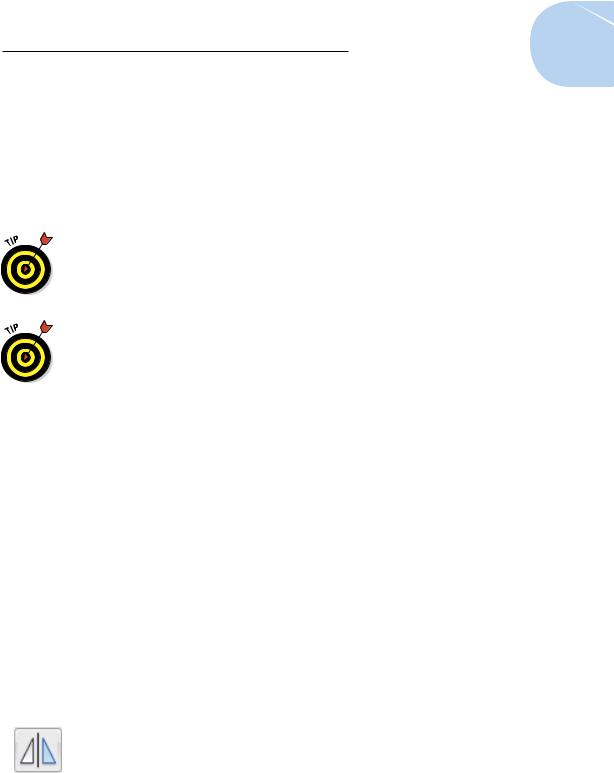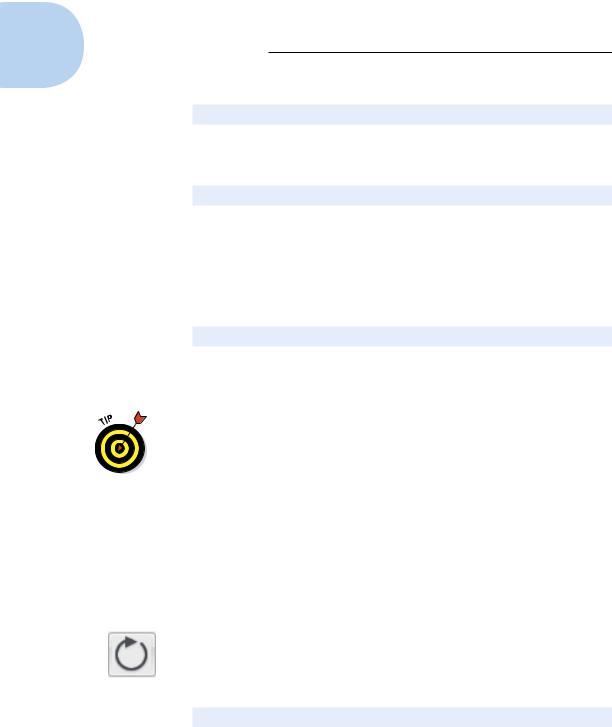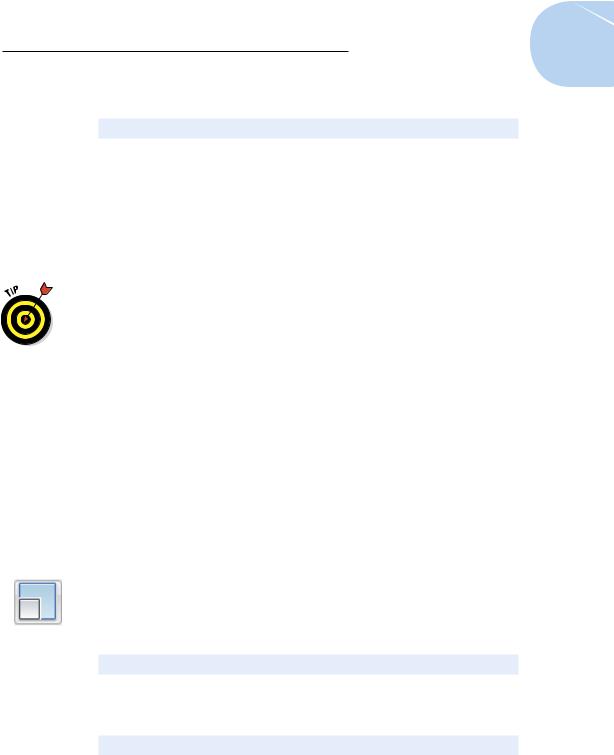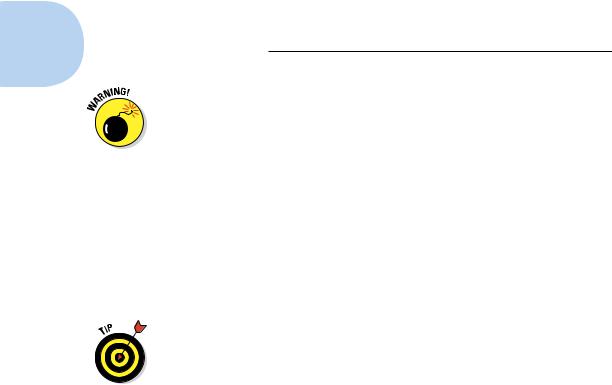
- •About the Authors
- •Dedication
- •Authors’ Acknowledgments
- •Table of Contents
- •Introduction
- •What’s Not (And What Is) in This Book
- •Mac attack!
- •Who Do We Think You Are?
- •How This Book Is Organized
- •Part I: AutoCAD 101
- •Part II: Let There Be Lines
- •Part III: If Drawings Could Talk
- •Part IV: Advancing with AutoCAD
- •Part V: On a 3D Spree
- •Part VI: The Part of Tens
- •But wait . . . there’s more!
- •Icons Used in This Book
- •A Few Conventions — Just in Case
- •Commanding from the keyboard
- •Tying things up with the Ribbon
- •Where to Go from Here
- •Why AutoCAD?
- •The Importance of Being DWG
- •Seeing the LT
- •Checking System Requirements
- •Suddenly, It’s 2013!
- •AutoCAD Does Windows (And Office)
- •And They’re Off: AutoCAD’s Opening Screens
- •Running with Ribbons
- •Getting with the Program
- •Looking for Mr. Status Bar
- •Let your fingers do the talking: The command window
- •The key(board) to AutoCAD success
- •Keeping tabs on palettes
- •Down the main stretch: The drawing area
- •Fun with F1
- •A Simple Setup
- •Drawing a (Base) Plate
- •Drawing rectangles on the right layers
- •Circling your plate
- •Nuts to you
- •Getting a Closer Look with Zoom and Pan
- •Modifying to Make It Merrier
- •Hip-hip-array!
- •Stretching out
- •Crossing your hatches
- •Following the Plot
- •A Setup Roadmap
- •Choosing your units
- •Weighing up your scales
- •Thinking annotatively
- •Thinking about paper
- •Defending your border
- •A Template for Success
- •Making the Most of Model Space
- •Setting your units
- •Making the drawing area snap-py (and grid-dy)
- •Setting linetype and dimension scales
- •Entering drawing properties
- •Making Templates Your Own
- •Setting Up a Layout in Paper Space
- •Will that be tabs or buttons?
- •View layouts Quick(View)ly
- •Creating a layout
- •Copying and changing layouts
- •Lost in paper space
- •Spaced out
- •A view(port) for drawing in
- •About Paper Space Layouts and Plotting
- •Managing Your Properties
- •Layer one on me!
- •Accumulating properties
- •Creating new layers
- •Manipulating layers
- •Using Named Objects
- •Using AutoCAD DesignCenter
- •Copying layers between drawings
- •Controlling Your Precision
- •Keyboard capers: Coordinate input
- •Understanding AutoCAD’s coordinate systems
- •Grab an object and make it snappy
- •Other Practical Precision Procedures
- •Introducing the AutoCAD Drawing Commands
- •The Straight and Narrow: Lines, Polylines, and Polygons
- •Toeing the line
- •Connecting the lines with polyline
- •Squaring off with rectangles
- •Choosing your sides with polygon
- •(Throwing) Curves
- •Going full circle
- •Arc-y-ology
- •Solar ellipses
- •Splines: The sketchy, sinuous curves
- •Donuts: The circles with a difference
- •Revision clouds on the horizon
- •Scoring Points
- •Commanding and Selecting
- •Command-first editing
- •Selection-first editing
- •Direct object manipulation
- •Choosing an editing style
- •Grab It
- •One-by-one selection
- •Selection boxes left and right
- •Perfecting Selecting
- •AutoCAD Groupies
- •Object Selection: Now You See It . . .
- •Get a Grip
- •About grips
- •A gripping example
- •Move it!
- •Copy, or a kinder, gentler Move
- •A warm-up stretch
- •Your AutoCAD Toolkit
- •The Big Three: Move, Copy, and Stretch
- •Base points and displacements
- •Move
- •Copy
- •Copy between drawings
- •Stretch
- •More Manipulations
- •Mirror
- •Rotate
- •Scale
- •Array
- •Offset
- •Slicing, Dicing, and Splicing
- •Trim and Extend
- •Break
- •Fillet and Chamfer and Blend
- •Join
- •When Editing Goes Bad
- •Zoom and Pan with Glass and Hand
- •The wheel deal
- •Navigating your drawing
- •Controlling your cube
- •Time to zoom
- •A View by Any Other Name . . .
- •Looking Around in Layout Land
- •Degenerating and Regenerating
- •Getting Ready to Write
- •Simply stylish text
- •Taking your text to new heights
- •One line or two?
- •Your text will be justified
- •Using the Same Old Line
- •Turning On Your Annotative Objects
- •Saying More in Multiline Text
- •Making it with Mtext
- •It slices; it dices . . .
- •Doing a number on your Mtext lists
- •Line up in columns — now!
- •Modifying Mtext
- •Gather Round the Tables
- •Tables have style, too
- •Creating and editing tables
- •Take Me to Your Leader
- •Electing a leader
- •Multi options for multileaders
- •How Do You Measure Up?
- •A Field Guide to Dimensions
- •The lazy drafter jumps over to the quick dimension commands
- •Dimension associativity
- •Where, oh where, do my dimensions go?
- •The Latest Styles in Dimensioning
- •Creating and managing dimension styles
- •Let’s get stylish!
- •Adjusting style settings
- •Size Matters
- •Details at other scales
- •Editing Dimensions
- •Editing dimension geometry
- •Editing dimension text
- •Controlling and editing dimension associativity
- •Batten Down the Hatches!
- •Don’t Count Your Hatches. . .
- •Size Matters!
- •We can do this the hard way. . .
- •. . . or we can do this the easy way
- •Annotative versus non-annotative
- •Pushing the Boundary (Of) Hatch
- •Your hatching has no style!
- •Hatch from scratch
- •Editing Hatch Objects
- •You Say Printing, We Say Plotting
- •The Plot Quickens
- •Plotting success in 16 steps
- •Get with the system
- •Configure it out
- •Preview one, two
- •Instead of fit, scale it
- •Plotting the Layout of the Land
- •Plotting Lineweights and Colors
- •Plotting with style
- •Plotting through thick and thin
- •Plotting in color
- •It’s a (Page) Setup!
- •Continuing the Plot Dialog
- •The Plot Sickens
- •Rocking with Blocks
- •Creating Block Definitions
- •Inserting Blocks
- •Attributes: Fill-in-the-Blank Blocks
- •Creating attribute definitions
- •Defining blocks that contain attribute definitions
- •Inserting blocks that contain attribute definitions
- •Edit attribute values
- •Extracting data
- •Exploding Blocks
- •Purging Unused Block Definitions
- •Arraying Associatively
- •Comparing the old and new ARRAY commands
- •Hip, hip, array!
- •Associatively editing
- •Going External
- •Becoming attached to your xrefs
- •Layer-palooza
- •Creating and editing an external reference file
- •Forging an xref path
- •Managing xrefs
- •Blocks, Xrefs, and Drawing Organization
- •Mastering the Raster
- •Attaching a raster image
- •Maintaining your image
- •Theme and Variations: Dynamic Blocks
- •Lights! Parameters!! Actions!!!
- •Manipulating dynamic blocks
- •Maintaining Design Intent
- •Defining terms
- •Forget about drawing with precision!
- •Constrain yourself
- •Understanding Geometric Constraints
- •Applying a little more constraint
- •AutoConstrain yourself!
- •Understanding Dimensional Constraints
- •Practice a little constraint
- •Making your drawing even smarter
- •Using the Parameters Manager
- •Dimensions or constraints — have it both ways!
- •The Internet and AutoCAD: An Overview
- •You send me
- •Send it with eTransmit
- •Rapid eTransmit
- •Bad reception?
- •Help from the Reference Manager
- •Design Web Format — Not Just for the Web
- •All about DWF and DWFx
- •Autodesk Design Review 2013
- •The Drawing Protection Racket
- •Autodesk Weather Forecast: Increasing Cloud
- •Working Solidly in the Cloud
- •Free AutoCAD!
- •Going once, going twice, going 123D
- •Your head planted firmly in the cloud
- •The pros
- •The cons
- •Cloudy with a shower of DWGs
- •AutoCAD 2013 cloud connectivity
- •Tomorrow’s Forecast
- •Understanding 3D Digital Models
- •Tools of the Trade
- •Warp speed ahead
- •Entering the third dimension
- •Untying the Ribbon and opening some palettes
- •Modeling from Above
- •Using 3D coordinate input
- •Using point filters
- •Object snaps and object snap tracking
- •Changing Planes
- •Displaying the UCS icon
- •Adjusting the UCS
- •Navigating the 3D Waters
- •Orbit à go-go
- •Taking a spin around the cube
- •Grabbing the SteeringWheels
- •Visualizing 3D Objects
- •Getting Your 3D Bearings
- •Creating a better 3D template
- •Seeing the world from new viewpoints
- •From Drawing to Modeling in 3D
- •Drawing basic 3D objects
- •Gaining a solid foundation
- •Drawing solid primitives
- •Adding the Third Dimension to 2D Objects
- •Creating 3D objects from 2D drawings
- •Modifying 3D Objects
- •Selecting subobjects
- •Working with gizmos
- •More 3D variants of 2D commands
- •Editing solids
- •Get the 2D Out of Here!
- •A different point of view
- •But wait! There’s more!
- •But wait! There’s less!
- •Do You See What I See?
- •Visualizing the Digital World
- •Adding Lighting
- •Default lighting
- •User-defined lights
- •Sunlight
- •Creating and Applying Materials
- •Defining a Background
- •Rendering a 3D Model
- •Autodesk Feedback Community
- •Autodesk Discussion Groups
- •Autodesk’s Own Bloggers
- •Autodesk University
- •The Autodesk Channel on YouTube
- •The World Wide (CAD) Web
- •Your Local ATC
- •Your Local User Group
- •AUGI
- •Books
- •Price
- •3D Abilities
- •Customization Options
- •Network Licensing
- •Express Tools
- •Parametrics
- •Standards Checking
- •Data Extraction
- •MLINE versus DLINE
- •Profiles
- •Reference Manager
- •And The Good News Is . . .
- •APERTURE
- •DIMASSOC
- •MENUBAR
- •MIRRTEXT
- •OSNAPZ
- •PICKBOX
- •REMEMBERFOLDERS
- •ROLLOVERTIPS
- •TOOLTIPS
- •VISRETAIN
- •And the Bonus Round
- •Index

Chapter 11: Edit for Credit 227
After you pick the second point, AutoCAD stretches the objects. Notice that the STRETCH command moved the two vertical lines because the crossing selection box contained both endpoints of both lines. STRETCH lengthened or shortened the four horizontal lines because the crossing selection box enclosed only one endpoint of each.
The STRETCH command takes some practice, but it’s worth the effort. Draw some additional kinds of objects and practice stretching with different crossing selection box locations as well as different base points and second points.
The STRETCH command prompt says Select objects to stretch by crossing-window or crossing-polygon, but picking points as in Step 4 doesn’t give you the crossing-polygon option. (See Chapter 10 if you need a refresher on crossing-polygon selection.) To use a polygonal crossing selection, type CP at the Select objects prompt and press Enter.
You can use more than one crossing window within a single run of the STRETCH command, and you can select objects that are outside a crossing window to have them move when other objects that cross the selection window(s) are stretched. The only objects that change size are stretchable objects that are crossed by a crossing window or polygon.
More Manipulations
The commands in this section — MIRROR, ROTATE, SCALE, ARRAY, and OFFSET — provide other ways (in addition to MOVE, COPY, and STRETCH) of manipulating objects or creating new versions of them. The procedures for each command assume that you’re familiar with the object selection and editing precision techniques presented in the MOVE, COPY, and STRETCH procedures (see Chapter 10 and the previous sections in this chapter).
Mirror
The MIRROR command creates a reverse copy of one or more objects. After you select your objects, AutoCAD prompts you to select two points that define a line about which the objects will be mirrored. You then have the option to retain or delete the source objects. Follow these steps to use the MIRROR command:
1.Press Esc to make sure that no command is active and no objects are selected.
2.Click the Mirror button on the Home tab’s Modify panel.
3.Select one or more objects, and then press Enter to end object selection.
www.it-ebooks.info

228 Part II: Let There Be Lines
AutoCAD prompts you to define the mirror line by picking points:
Specify first point of mirror line:
4.Specify the start of the mirror line by clicking a point or typing coordinates.
AutoCAD prompts
Specify second point of mirror line:
5. Pick a second point.
Most of the time, you’ll want to have Polar Tracking or Ortho mode enabled so you can mirror your objects precisely. You can also use object snaps on existing objects, including ones being mirrored. The latter case is used when you want to ensure exact symmetry between the source and the mirrored objects. The mirrored copies temporarily disappear, and AutoCAD prompts
Erase source objects? [Yes/No] <N>:
If you type Y at the final prompt, the source objects disappear, and you’re left with the new mirrored copy. Accept the default No option if you want to retain the source objects along with the mirrored copies.
Normally when you mirror text or dimensions, the words come out backward. The system variable MIRRTEXT can handle that little problem. By default, MIRRTEXT is turned off (that is, its value is 0) so the text itself still reads the right way around after the objects are mirrored. If you really want your drawing text to be backward, change the value of MIRRTEXT to 1. (We cover system variables in a little more detail in Chapter 26.)
Rotate
The ROTATE command pivots one or more objects around a point that you specify. Follow these steps to use the ROTATE command:
1.Press Esc to make sure that no command is active and no objects are selected.
2.Click the Rotate button on the Home tab’s Modify panel.
3.Select one or more objects and then press Enter to end object selection.
AutoCAD prompts you for the base point for rotating the selected objects:
Specify base point:
4. Specify a base point by clicking a point or typing coordinates.
www.it-ebooks.info

Chapter 11: Edit for Credit 229
The base point becomes the point around which AutoCAD rotates the objects. You also have to specify a rotation angle:
Specify rotation angle or [Copy/Reference] <0>:
5.Specify a rotation angle by typing an angle measurement and pressing Enter, or just press Enter to accept the default value shown in angle brackets.
Alternatively, you can indicate an angle on the screen by moving the crosshairs until the Coordinates section of the status bar indicates the desired angle and then clicking. If you choose this alternative, you will need to use Ortho mode or Polar Tracking to indicate a precise angle (for example, 90 or 45 degrees) or an object snap to rotate an object so it aligns precisely with other objects.
Positive angle values rotate things counter-clockwise (counter to what you might expect) and negative values go clockwise. For example, entering 270 degrees or -90 degrees produces the same result.
After you specify the rotation angle by typing or picking, AutoCAD rotates the objects into their new position. The ROTATE command’s Copy option makes a rotated copy while leaving the source object in place.
Scale
If you read all our harping about drawing scales and scale factors in Chapter 4, you may think that the SCALE command performs some magical scale transformation on your entire drawing. No such luck. It also has nothing to do with ladders or fish. It merely uniformly scales (enlarges or reduces) one or more objects up or down by a factor that you specify. Here’s how it works:
1.Press Esc to make sure that no command is active and no objects are selected.
2.Click the Scale button on the Home tab’s Modify panel.
3.Select one or more objects and then press Enter to end object selection.
AutoCAD prompts you for the base point around which it will scale all the selected objects:
Specify base point:
4. Specify a base point by picking a point or typing coordinates.
The base point becomes the point around which the objects are scaled. AutoCAD prompts you for the scale factor:
Specify scale factor or [Copy/Reference] <1.0000>:
www.it-ebooks.info

230 Part II: Let There Be Lines
Don’t assume that AutoCAD will scale the objects but leave them more or less where they are in the drawing. AutoCAD scales the distance between objects as well as the objects themselves. For example, if you select a circle to scale, pick a point outside the circle as the base point and then specify a scale factor of 2. AutoCAD not only makes the circle twice as big, but also moves the circle twice as far away from the base point that you specified. If you want to make a circle bigger but leave it where it’s currently located, make sure that you use the CEN object snap to select its center point as the base point for the scale operation.
5.Type a scale factor and press Enter.
AutoCAD scales the objects by the factor that you type, using the base point that you specified. Numbers greater than 1 increase the objects’ sizes. Numbers smaller than 1 but greater than zero decrease the objects’ sizes. Negative scale factors are invalid.
Just like the ROTATE command, SCALE also has a copy option with which you can make enlarged or reduced duplicates of selected objects — without altering the source objects. And both SCALE and ROTATE remember the last scale factor or rotation angle entered throughout the drawing session.
Array
The ARRAY command is like a supercharged COPY: You use it to create a rectangular grid of objects at regular X and Y spacings or a radial arrangement of objects around a center point at a regular angular spacing. For example, you can use rectangular arrays to populate an auditorium with chairs or a polar array to populate a bicycle wheel with spokes.
The kind of array we describe in this chapter is the old-style — but still very useful — non-associative array. (we cover the new-style array in Chapter 18). Non-associative arrays are simply copies of the source object; they dwell on the same layers as their source, and they can be edited individually, even in older releases of AutoCAD.
The following steps describe how to create a rectangular array, which you’ll probably do more often than creating a polar array:
1.Press Esc to make sure that no command is active and no objects are selected.
2.Type -ARRAY (don’t forget the hyphen) and press Enter.
Typing a hyphen in front of an AutoCAD command normally tells the program to run at the command line rather than in a dialog box. Starting with AutoCAD 2012, typing ARRAY runs the associative array tool, whereas typing -ARRAY runs the non-associative version.
www.it-ebooks.info
